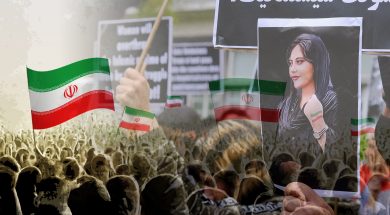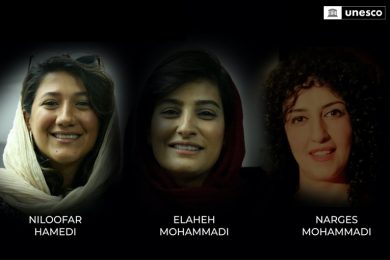For decades, Iranian women have led the fight for freedom, justice, and equality despite relentless oppression from the Islamic Republic and its enforcement arm, the IRGC. While many brave women continue to resist within Iran, others have been forced into exile, yet their fight has not stopped. Instead, they have taken their resistance beyond Iran’s borders, using media, activism, diplomacy, and advocacy to expose the regime’s crimes, amplify the voices of those still inside Iran, and mobilize global solidarity.
This analysis explores:
• The key reasons why Iranian women go into exile
• How they continue the fight for justice from abroad
• The challenges and dangers they face
• Their impact on international awareness and policy
• The global role in supporting Iranian women’s movement
1. Why Iranian Women Are Forced Into Exile
Many Iranian women activists, journalists, and dissidents flee the country due to:
A. Political Persecution by the IRGC
• The IRGC systematically arrests, tortures, and imprisons women who challenge the regime.
• Charges like “acting against national security” and “propaganda against the state” are commonly used to silence them.
• Prison conditions, including sexual violence and psychological torture, push many to seek safety abroad.
B. Gender Oppression and Bodily Autonomy
• Women’s rights activists face brutal crackdowns for fighting against compulsory hijab laws and gender-based discrimination.
• Many are beaten, jailed, or even killed for their peaceful defiance.
• The lack of legal protections for women leads many to seek freedom elsewhere.
C. Fear of Execution
• The regime has executed women activists and political prisoners, making exile the only chance for survival.
• Some activists flee after multiple arrests, fearing that the next arrest could be their last.
D. Digital Activism and Cyber Suppression
• Many women journalists and activists use social media to expose human rights abuses.
• The IRGC’s cyber unit cracks down on digital activists, hacking accounts, issuing threats, and targeting families inside Iran.
• Fleeing the country allows continued online activism without the same level of immediate physical danger.
2. How Exiled Iranian Women Continue the Fight for Justice
A. Raising Global Awareness Through Media and Journalism
• Many exiled Iranian women, like Masih Alinejad, use social media and independent news platforms to spread awareness about human rights abuses in Iran.
• They publish investigative reports on the IRGC’s crimes, including torture, executions, and political repression.
• Satellite channels, Persian-language media, and global news outlets amplify their voices.
B. Lobbying Governments and International Organizations
• Exiled women activists work with UN agencies, human rights organizations, and Western governments to push for:
✔ Sanctions against IRGC leaders involved in human rights abuses.
✔ Investigations into Iran’s crimes against humanity.
✔ Recognition of Iran’s feminist revolution as a legitimate struggle for freedom.
C. Digital Activism and Online Campaigns
• Social media campaigns like #WomenLifeFreedom and #MahsaAmini mobilized millions worldwide.
• Activists in exile help Iranians bypass internet censorship by providing:
✔ Secure VPN access
✔ Encrypted communication tools
✔ Platforms for whistleblowers inside Iran to share evidence of repression
D. Organizing Protests and Advocacy Events
• Iranian women in exile organize rallies, marches, and demonstrations in major cities worldwide, ensuring that:
✔ The fight for women’s rights in Iran remains a global issue.
✔ Governments feel pressure to act against the regime.
✔ The names of imprisoned activists are not forgotten.
E. Supporting Women Inside Iran
• Many exiled activists provide financial aid, legal assistance, and psychological support to victims of state violence and their families.
• They establish underground networks to help dissidents escape Iran when necessary.
3. Challenges Faced by Exiled Iranian Women
A. Threats from the IRGC Abroad
• The IRGC operates globally, targeting dissidents through:
✔ Assassination attempts (e.g., attempted kidnappings of activists in the U.S. and Europe).
✔ Cyberattacks and disinformation campaigns to discredit their activism.
✔ Pressure on families inside Iran, using them as hostages to silence those in exile.
B. Legal and Immigration Barriers
• Many women flee without passports or legal protection, making asylum-seeking difficult.
• Some governments do not recognize gender-based persecution as a reason for asylum.
• Refugee status can mean years of uncertainty, limiting their activism.
C. Psychological Toll of Exile
• Being separated from family and home is emotionally devastating.
• Watching friends and fellow activists suffer in prison causes survivor’s guilt.
• Constant threats from the regime create anxiety and fear even in supposed safety.
4. The Impact of Exiled Iranian Women on Global Advocacy
A. Inspiring International Feminist Movements
• Iranian women’s resistance has energized global feminist struggles.
• The “Women, Life, Freedom” slogan has been adopted in feminist protests worldwide.
• Their activism challenges Western feminist groups to prioritize women’s rights in Iran.
B. Strengthening Sanctions Against the IRGC
• Exiled activists successfully lobbied for:
✔ The U.S. designation of the IRGC as a terrorist organization.
✔ EU debates on IRGC blacklisting.
✔ Targeted sanctions on Iranian officials involved in repression.
C. Changing Public Opinion on Iran
• Their activism has exposed the IRGC’s role in global terrorism, cyber warfare, and human rights abuses.
• They counter regime propaganda, showing that Iranian people oppose the dictatorship.
5. The Global Role in Supporting Iranian Women in Exile
A. Providing Asylum and Protection
• Governments must offer fast-track asylum for Iranian women activists at risk.
• Security agencies must investigate IRGC threats against dissidents abroad.
B. Amplifying Their Voices
• International media should prioritize covering exiled Iranian women’s activism.
• Global human rights organizations should ensure their cases remain high-profile.
C. Holding the IRGC Accountable
• Governments should:
✔ Blacklist the IRGC as a terrorist organization globally.
✔ Support international criminal investigations into Iran’s gender-based persecution.
D. Supporting Digital Freedom
• Tech companies should offer secure platforms for activists to continue their work.
• Governments should fund initiatives that help Iranians bypass censorship.
Conclusion: The Fight Continues Beyond Borders
Exiled Iranian women activists are proving that distance does not weaken resistance—it strengthens it. They are journalists exposing the truth, activists mobilizing support, and leaders shaping international policy. Despite the threats, exile, and challenges, their voices continue to inspire Iranians inside and outside the country.
Join Our Newsletter!
Stay informed with the latest updates, news, and ways to take action in the fight for justice and global security. Sign up now to get updates delivered straight to your inbox!





